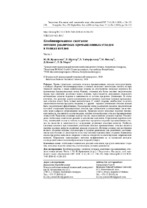| dc.contributor.author | Ярмольчик, Ю. П. | |
| dc.contributor.author | Шрёгер, Р. | |
| dc.contributor.author | Хаберфельнер, Х. | |
| dc.contributor.author | Пихлер, М. | |
| dc.contributor.author | Костич, Д. | |
| dc.contributor.author | Мороз, Г. В. | |
| dc.coverage.spatial | Минск | ru |
| dc.date.accessioned | 2020-05-28T12:49:56Z | |
| dc.date.available | 2020-05-28T12:49:56Z | |
| dc.date.issued | 2020 | |
| dc.identifier.citation | Комбинированное сжигание потоков различных промышленных отходов в топках котлов. Часть 1 = Combined Combustion of Various Industrial Waste Flows in Boiler Furnaces. Part 1 / Ю. П. Ярмольчик [и др.] // Энергетика. Известия высших учебных заведений и энергетических объединений СНГ. – 2020. – № 3. – С. 236-252. | ru |
| dc.identifier.uri | https://rep.bntu.by/handle/data/72985 | |
| dc.description.abstract | Прямое факельное сжигание потоков промышленных отходов непосредственно в камерах сгорания теплогенерирующих установок позволяет значительно снизить потери тепловой энергии, а также капитальные затраты на обустройство тепловых агрегатов без применения предварительных топок. Однако, учитывая все более жесткие экологические нормы при сжигании различных видов топлива, представляется актуальным определить оптимальные условия горения в зависимости от состава продуктов утилизации. В статье отмечено, что решение задачи организации качественного сжигания потоков промышленных отходов может быть только комплексным. С одной стороны, необходимо получить экологически чистые продукты сгорания, а с другой – процесс утилизации отходов должен быть энергетически эффективным. Рассмотрены этапы реализации проектов энергетически полезной утилизации промышленных отходов при соблюдении установленных экологических норм выбросов загрязняющих веществ. Проведен анализ исходных горючих химических веществ, входящих в состав твердых, жидких и газообразных отходов промышленных технологий. Выделены основные классы топлив, определяющих реакции горения. Рассмотрены глобальные химические реакции и механизмы окисления. Определены горючие свойства, химический состав и степень воздействия продуктов сгорания промышленных отходов на экологию в зависимости от содержания различных исходных веществ. Наиболее сложным аспектом при пламенной утилизации потоков промышленных отходов является наличие вредных веществ различных классов опасности. Изучены условия для достижения полного сгорания топлива, стехиометрия и условия равновесия для различного соотношения воздух/топливо (в зависимости от состава топлива) при неполном сгорании. Приведены анализ продуктов неполного сгорания и классы опасности соответствующих загрязняющих веществ. Определено максимальное значение коэффициента φ, за пределами которого в однородной смеси должен образоваться твердый углерод. | ru |
| dc.language.iso | ru | ru |
| dc.publisher | БНТУ | ru |
| dc.title | Комбинированное сжигание потоков различных промышленных отходов в топках котлов. Часть 1 | ru |
| dc.title.alternative | Combined Combustion of Various Industrial Waste Flows in Boiler Furnaces. Part 1 | ru |
| dc.type | Article | ru |
| dc.identifier.doi | 10.21122/1029-7448-2020-63-3-236-252 | |
| local.description.annotation | Direct flaring of industrial waste flows specifically in the combustion chambers of heat generating plants makes it possible to significantly reduce the loss of thermal energy, as well as the capital costs of equipping thermal units without using of preliminary furnaces. However, given the increasingly strict environmental standards for the burning of various fuels, it seems important to determine the optimal combustion conditions depending on the composition of the waste products. The article shows that only a complex solution can be a successful solution to the problem of organizing high-quality combustion of industrial waste flows. On the one hand, it is necessary to obtain extremely environmentally friendly combustion products, and, on the other hand, the waste disposal process should be energy efficient. The article discusses the stages of the implementation of the projects of energy-efficient utilization of industrial waste in compliance with the established environmental standards for emissions of pollutants. The analysis of initial combustible chemical substances that are part of solid, liquid and gaseous wastes of industrial technologies is given. The main classes of fuels that determine combustion reactions are identified. Global chemical reactions and oxidation mechanisms are considered. The combustible properties, chemical composition, and degree of impact of the products of combustion of industrial waste on the environment are determined, depending on the content of various starting substances. The most difficult aspect of the flaming disposal of industrial waste flows is the presence of harmful substances of various hazard classes. The conditions for achieving complete fuel combustion, stoichiometry, and equilibrium conditions for different air/fuel ratios (depending on fuel composition) with incomplete combustion are determined. The analysis of products of incomplete combustion is given as well as of and hazard classes of the corresponding pollutants. The maximum value of the coefficient φ was determined beyond which solid carbon should be formed in a homogeneous mixture. | ru |

